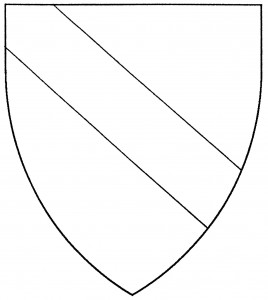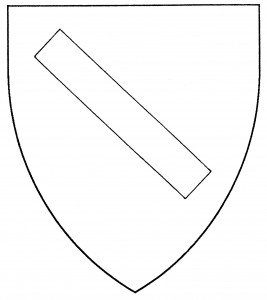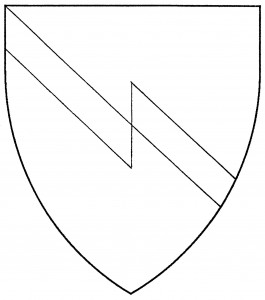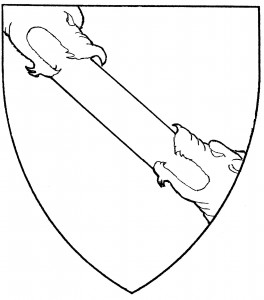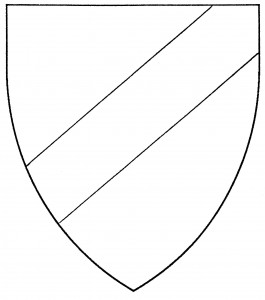The bend is an heraldic ordinary, a diagonal stripe from the dexter chief to the sinister base of the shield. Its diminutive is the “bendlet”; Society blazonry does not recognize any other terms for the bend’s diminutives.
The “baton” or “baston” was originally another term for the bendlet; but by the 14th Century it had acquired the meaning of “bend couped”, and this is both its modern and its Society interpretation.
Like all ordinaries, the bend is subject to the usual lines of division: engrailed, wavy, &c. Of the usages peculiar to the bend: The “bend embattled” is only embattled on its upper edge, unless specifically blazoned “(embattled) counter-embattled” or “bretessed”. The “bend enarched” (or “embowed”) curves to chief unless otherwise specified; it was originally meant to depict the convexity of the shield, and consequently carries no heraldic difference.
The “bend bevilled” or “beviled” is divided vertically and offset; it is found in the arms of Zorke, temp. Henry VI [Gwynn-Jones 26]. Using other charges on the field with a bend bevilled is considered a step from period practice.
The “bend engouled” (from a term meaning “devoured”) has beasts’ heads on either end, issuant from the edges of the shield and overlying the bend: this is an Iberian usage, as seen in the arms of Freire de Andrade or Dandrade, c.1540 [Nobreza xi]. The type of head should be specified: dragons’ heads (also called serpents’ heads) were most commonly used in period.
The bend sinister is the mirror image of the bend, running from sinister chief to dexter base. It was originally merely a way of displaying the bend, when the entire shield was turned to sinister (e.g., when displaying marital coats); but by the end of period it was being treated as a charge in its own right [Legh 64v]. While some texts have said the bend sinister was a mark of bastardy, it was no more so than any other cadency charge. Its diminutives may be called “bendlets sinister” or “scarpes”. In other respects, the comments on the bend apply to the bend sinister as well.
Eglentyne Merryweather bears: Vert, a bend vair.
Stephen de Montfort bears: Gules, a bend argent cotised Or.
Kendra Grey bears: Per bend sinister argent and vert, two batons sinister counterchanged.
Michael of Braghan bears: Azure, a bend bevilled argent.
Domnhall na Moicheirghe bears: Azure, two bendlets lozengy conjoined at the points argent.
Drueta de la Rosa bears: Gules, three bendlets sinister ermine.
Illuminada Eugenia de Guadalupe y Godoy bears: Sable, a bend engouled of two wolf’s heads Or.
